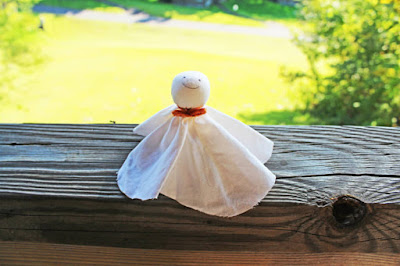While Makoto Shinkai’s latest film, “Weathering With You,” has already been released in Japan, it’s likely anime fans overseas won’t be able to see the movie until 2020. However, there are a few moments in the film that may leave international audiences scratching their heads when they finally get to see it.
Ghost-like figures with strings tied around their necks can be seen throughout the movie, from rain-soaked hospital windows to umbrellas adorned with the smiling dolls. Even the Twitter emoji for #WeatheringWithYou is one of the white objects. But what the heck are these things?
They’re teru teru bōzu charms, which serve a special purpose in Japanese culture. They are believed to help stop the rain and guarantee that tomorrow will be sunny.
Teru teru bōzu, which literally translates to “shine shine monk,” are typically made by children with tissue paper and are hung around window sills. It’s a fairly simple craft project for kids to do when they are stuck inside on a rainy day.
Japan is known for an annual rainy season that brings rain clouds in June and July. This summer saw a historic rainy season, which ended up being the cloudiest period in Tokyo in 129 years.
According to tenki.jp, one of the most popular weather websites in Japan, teru teru bōzu can trace its origins to China back during the Heian Period (794-1185). There are several legends in Japan about the doll’s origin, but one of the most well-known tales is of a monk who promised he could bring clear skies the next day. Legend has it that the monk chanted nonstop in front of a feudal lord and was beheaded when he failed to stop the rain.
There’s even a children’s song about teru teru bōzu that alludes to this tale with some explicit lyrics. The last line of the song reads, “If tomorrow is cloudy and crying, I’ll cut your head off.”
While teru teru bōzu may have a dark history, the paper dolls have become a ubiquitous part of the Japanese zeitgeist that make people think of antsy kids who want to play in the sun rather than a monk who lost his head for failing to part the clouds.
(Source: JT)
Ghost-like figures with strings tied around their necks can be seen throughout the movie, from rain-soaked hospital windows to umbrellas adorned with the smiling dolls. Even the Twitter emoji for #WeatheringWithYou is one of the white objects. But what the heck are these things?
They’re teru teru bōzu charms, which serve a special purpose in Japanese culture. They are believed to help stop the rain and guarantee that tomorrow will be sunny.
 | |
| Teru teru bōzu charms are believed to help stop the rain and guarantee that the next day will be sunny. | GETTY IMAGES |
Teru teru bōzu, which literally translates to “shine shine monk,” are typically made by children with tissue paper and are hung around window sills. It’s a fairly simple craft project for kids to do when they are stuck inside on a rainy day.
Japan is known for an annual rainy season that brings rain clouds in June and July. This summer saw a historic rainy season, which ended up being the cloudiest period in Tokyo in 129 years.
According to tenki.jp, one of the most popular weather websites in Japan, teru teru bōzu can trace its origins to China back during the Heian Period (794-1185). There are several legends in Japan about the doll’s origin, but one of the most well-known tales is of a monk who promised he could bring clear skies the next day. Legend has it that the monk chanted nonstop in front of a feudal lord and was beheaded when he failed to stop the rain.
There’s even a children’s song about teru teru bōzu that alludes to this tale with some explicit lyrics. The last line of the song reads, “If tomorrow is cloudy and crying, I’ll cut your head off.”
While teru teru bōzu may have a dark history, the paper dolls have become a ubiquitous part of the Japanese zeitgeist that make people think of antsy kids who want to play in the sun rather than a monk who lost his head for failing to part the clouds.
(Source: JT)
No comments:
Post a Comment